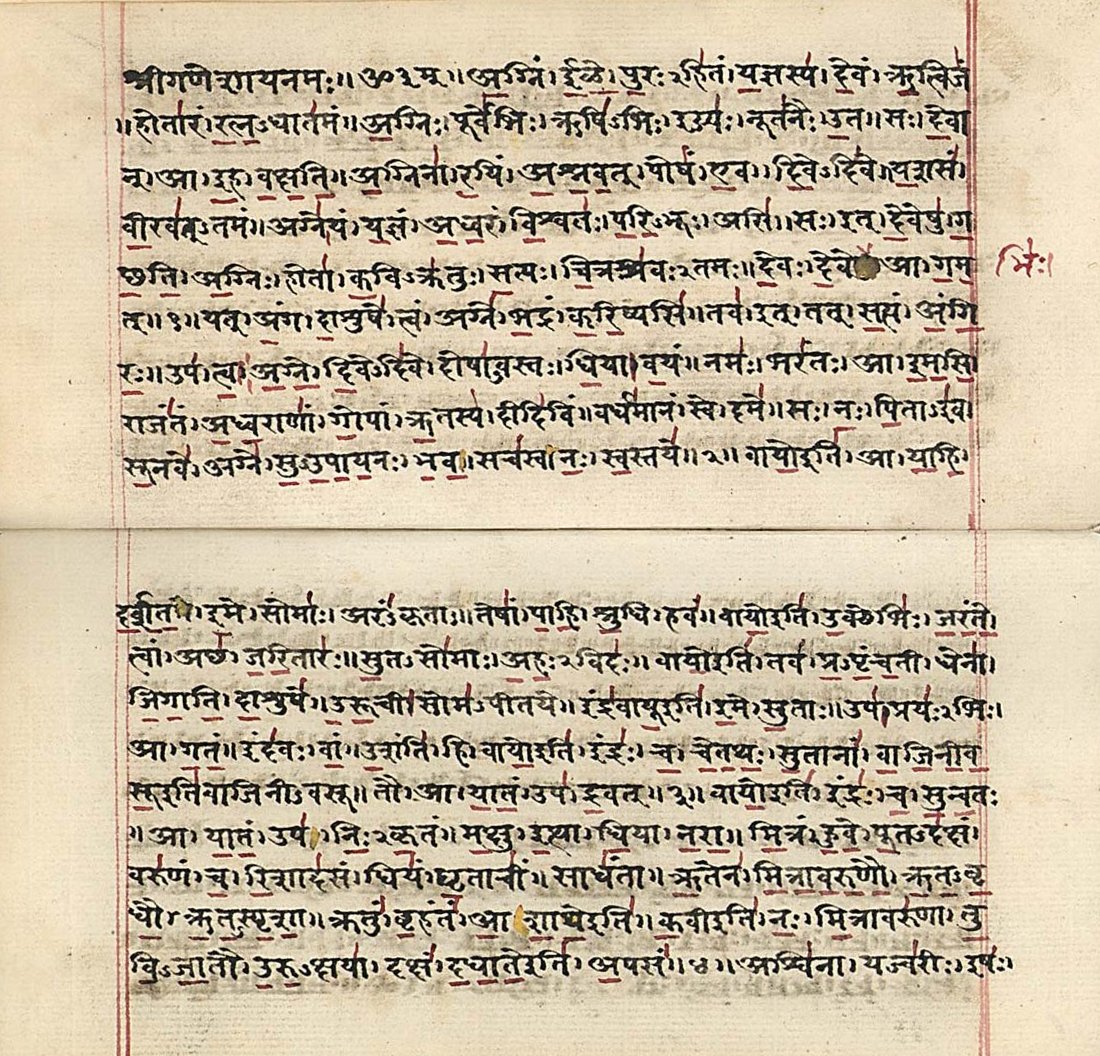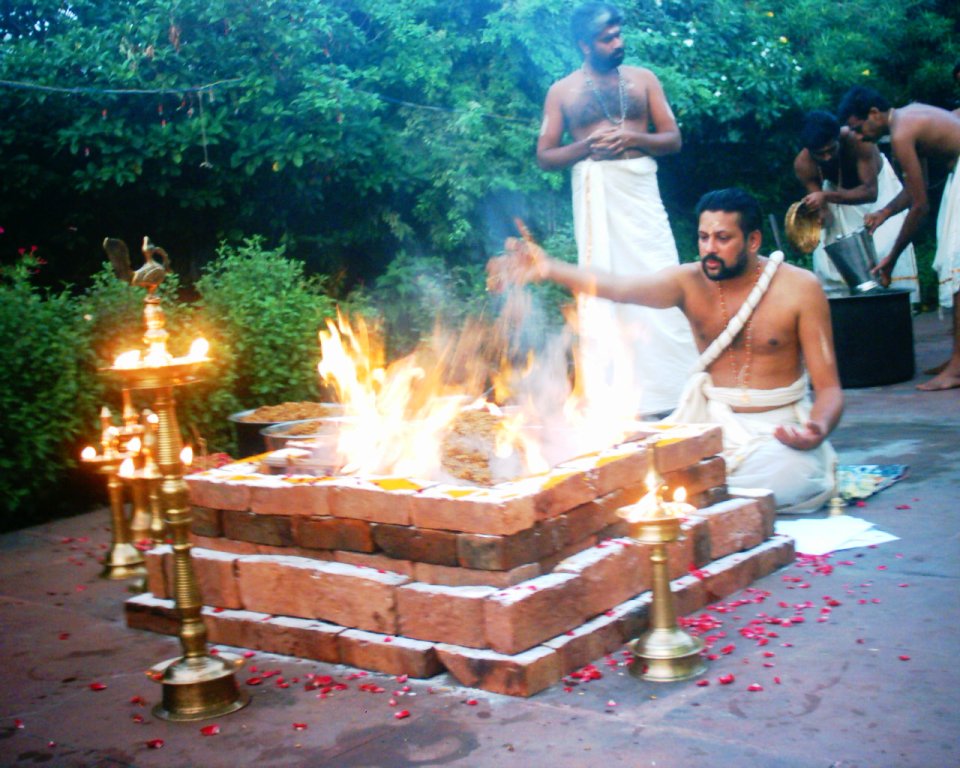|
≈öruti
''≈öruti'' or shruti (, , ) in Sanskrit means "that which is heard" and refers to the body of most authoritative, ancient religious texts comprising the central canon of Hinduism. Manusmriti states: ''≈örutistu vedo vij√±eya·∏•'' (Devanagari: ý§∂ý•çý§∞ý•Åý§§ý§øý§∏ý•çý§§ý•Å ý§µý•áý§¶ý•ã ý§µý§øý§úý•çý§ûý•áý§Øý§É) meaning, "Know that Vedas are ≈öruti". Thus, it includes the four Vedas including its four types of embedded texts‚Äîthe Samhitas, the Upanishads, the Brahmanas and the Aranyakas.Wendy Doniger O'Flaherty (1988), Textual Sources for the Study of Hinduism, Manchester University Press, , pages 2-3 ''≈öruti''s has been variously described as a revelation through ''anubhava'' (direct experience), or of primordial origins realized by ancient Rishis.James Lochtefeld (2002), "Shruti", The Illustrated Encyclopedia of Hinduism, Vol. 2: N‚ÄìZ, Rosen Publishing. , page 645 In Hindu tradition, they have been referred to as ''apauru·π£eya'' (not created by humans). The ''≈öruti'' text ... [...More Info...] [...Related Items...] OR: [Wikipedia] [Google] [Baidu] [Amazon] |
Hinduism
Hinduism () is an Hypernymy and hyponymy, umbrella term for a range of Indian religions, Indian List of religions and spiritual traditions#Indian religions, religious and spiritual traditions (Sampradaya, ''sampradaya''s) that are unified by adherence to the concept of ''dharma'', a Ṛta, cosmic order maintained by its followers through rituals and righteous living, as expounded in the Vedas. The word ''Hindu'' is an exonym, and while Hinduism has been called the oldest religion in the world, it has also been described by the modern term ''Sanātana Dharma'' () emphasizing its eternal nature. ''Vaidika Dharma'' () and ''Arya dharma'' are historical endonyms for Hinduism. Hinduism entails diverse systems of thought, marked by a range of shared Glossary of Hinduism terms, concepts that discuss God in Hinduism, theology, Hindu mythology, mythology, among other topics in Hindu texts, textual sources. Hindu texts have been classified into Śruti () and Smṛti (). The major Hin ... [...More Info...] [...Related Items...] OR: [Wikipedia] [Google] [Baidu] [Amazon] |
Sm·πõti
' (, , ), also spelled ' or ', is a body of Hindu texts representing the remembered, written tradition in Hinduism, rooted in or inspired by the Vedas. works are generally attributed to a named author and were transmitted through manuscripts, in contrast to Vedic or literature, which is based on a fixed text with no specific author, and preserved through oral transmission. are derivative, secondary works and considered less authoritative than in Hinduism, except in the Mīmāmsa school of Hindu philosophy.James Lochtefeld (2002), "Smrti", The Illustrated Encyclopedia of Hinduism, Vol. 2: N–Z, Rosen Publishing, , page 656-657 The authority of accepted by orthodox schools is derived from that of , on which it is based. The literature is a corpus of varied texts that includes: the six (the auxiliary sciences in the Vedas), the epics (the and ), the and (or ), the , the , the or poetical literature, extensive (reviews and commentaries on and non- texts), and numerou ... [...More Info...] [...Related Items...] OR: [Wikipedia] [Google] [Baidu] [Amazon] |
Mīmāṃsā
''Mƒ´mƒÅ·πÅsƒÅ'' (Sanskrit: ý§Æý•Äý§Æý§æý§Çý§∏ý§æ; IAST: Mƒ´mƒÅ·πÉsƒÅ) is a Sanskrit word that means "reflection" or "critical investigation" and thus refers to a tradition of contemplation which reflected on the meanings of certain Vedic texts. This tradition is also known as P≈´rva-Mƒ´mƒÅ·πÅsƒÅ because of its focus on the earlier (''p≈´rva'') Vedic texts dealing with ritual actions, and similarly as Karma-Mƒ´mƒÅ·πÅsƒÅ due to its focus on ritual action (''karma'').Chris Bartley (2013), "Purva Mimamsa", in ''Encyclopaedia of Asian Philosophy'' (Editor: Oliver Leaman), Routledge, 978-0415862530, pages 443‚Äì445. It is one of six Vedic "affirming" ( ƒÅstika) schools of Hindu philosophy. This particular school is known for its philosophical theories on the nature of Dharma, based on hermeneutics of the Vedas, especially the BrƒÅ·∏•manas and samhitas.Oliver Leaman (2006), Shruti, in ''Encyclopaedia of Asian Philosophy'', Routledge, , page 503. The Mƒ´mƒÅ·πÉsƒÅ school was foundati ... [...More Info...] [...Related Items...] OR: [Wikipedia] [Google] [Baidu] [Amazon] |
Vedas
FIle:Atharva-Veda samhita page 471 illustration.png, upright=1.2, The Vedas are ancient Sanskrit texts of Hinduism. Above: A page from the ''Atharvaveda''. The Vedas ( or ; ), sometimes collectively called the Veda, are a large body of religious texts originating in ancient India. Composed in Vedic Sanskrit, the texts constitute the oldest layer of Sanskrit literature and the oldest Hindu texts, scriptures of Hinduism. There are four Vedas: the Rigveda, the Yajurveda, the Samaveda and the Atharvaveda. Each Veda has four subdivisions – the Samhitas (mantras and benedictions), the Brahmanas (commentaries on and explanation of rituals, ceremonies and sacrifices – Yajñas), the Aranyakas (text on rituals, ceremonies, sacrifices and symbolic-sacrifices), and the Upanishads (texts discussing meditation, philosophy and spiritual knowledge).Gavin Flood (1996), ''An Introduction to Hinduism'', Cambridge University Press, , pp. 35–39A Bhattacharya (2006), ''Hindu Dharma: Introduc ... [...More Info...] [...Related Items...] OR: [Wikipedia] [Google] [Baidu] [Amazon] |
Upanishads
The Upanishads (; , , ) are late Vedic and post-Vedic Sanskrit texts that "document the transition from the archaic ritualism of the Veda into new religious ideas and institutions" and the emergence of the central religious concepts of Hinduism. They are the most recent addition to the Vedas, the oldest scriptures of Hinduism, and deal with meditation, philosophy, consciousness, and ontological knowledge. Earlier parts of the Vedas dealt with mantras, benedictions, rituals, ceremonies, and sacrifices.A Bhattacharya (2006), ''Hindu Dharma: Introduction to Scriptures and Theology'', , pp. 8–14; George M. Williams (2003), Handbook of Hindu Mythology, Oxford University Press, , p. 285Jan Gonda (1975), ''Vedic Literature: (Saṃhitās and Brāhmaṇas)'', Otto Harrassowitz Verlag, While among the most important literature in the history of Indian religions and culture, the Upanishads document a wide variety of "rites, incantations, and esoteric knowledge" departing from Vedic ... [...More Info...] [...Related Items...] OR: [Wikipedia] [Google] [Baidu] [Amazon] |
Brahmanas
The Brahmanas (; Sanskrit: , International Alphabet of Sanskrit Transliteration, IAST: ''Brāhmaṇam'') are Vedas, Vedic śruti works attached to the Samhitas (hymns and mantras) of the Rigveda, Rig, Samaveda, Sama, Yajurveda, Yajur, and Atharvaveda, Atharva Vedas. They are a secondary layer or classification of Sanskrit texts embedded within each Veda, which explain and instruct on the performance of Yajna, Vedic rituals (in which the related Samhitas are recited). In addition to explaining the symbolism and meaning of the Samhitas, Brahmana literature also expounds scientific knowledge of the Vedic period, Vedic Period, including observational astronomy and, particularly in relation to altar construction, geometry. Divergent in nature, some Brahmanas also contain mystical and philosophical material that constitutes Aranyakas and Upanishads. Each Veda has one or more of its own Brahmanas, and each Brahmana is generally associated with a particular Shakha or Vedic school. Less ... [...More Info...] [...Related Items...] OR: [Wikipedia] [Google] [Baidu] [Amazon] |
Aranyaka
The ''Aranyakas'' (; ; IAST: ') are a part of the ancient Indian Vedas concerned with the meaning of ritual sacrifice, composed in about 700 BC. They typically represent the later sections of the Vedas, and are one of many layers of Vedic texts. The other parts of the Vedas are the Samhitas (benedictions, hymns), Brahmanas (commentary), and the Upanishads (spirituality and abstract philosophy).A Bhattacharya (2006), Hindu Dharma: Introduction to Scriptures and Theology, , pages 8-14 ''Aranyakas'' describe and discuss rituals from various perspectives; some include philosophical speculations. For example, the Katha Aranyaka discusses rituals connected with the ''Pravargya''. The Aitareya Aranyaka includes explanation of the ''Mahavrata'' ritual from ritualisitic to symbolic meta-ritualistic points of view. ''Aranyakas'', however, neither are homogeneous in content nor in structure. ''Aranyakas'' are sometimes identified as ''karma-kanda'' (ý§ïý§∞ý•çý§Æý§ïý§æý§£ý•çý§°), ritualist ... [...More Info...] [...Related Items...] OR: [Wikipedia] [Google] [Baidu] [Amazon] |


